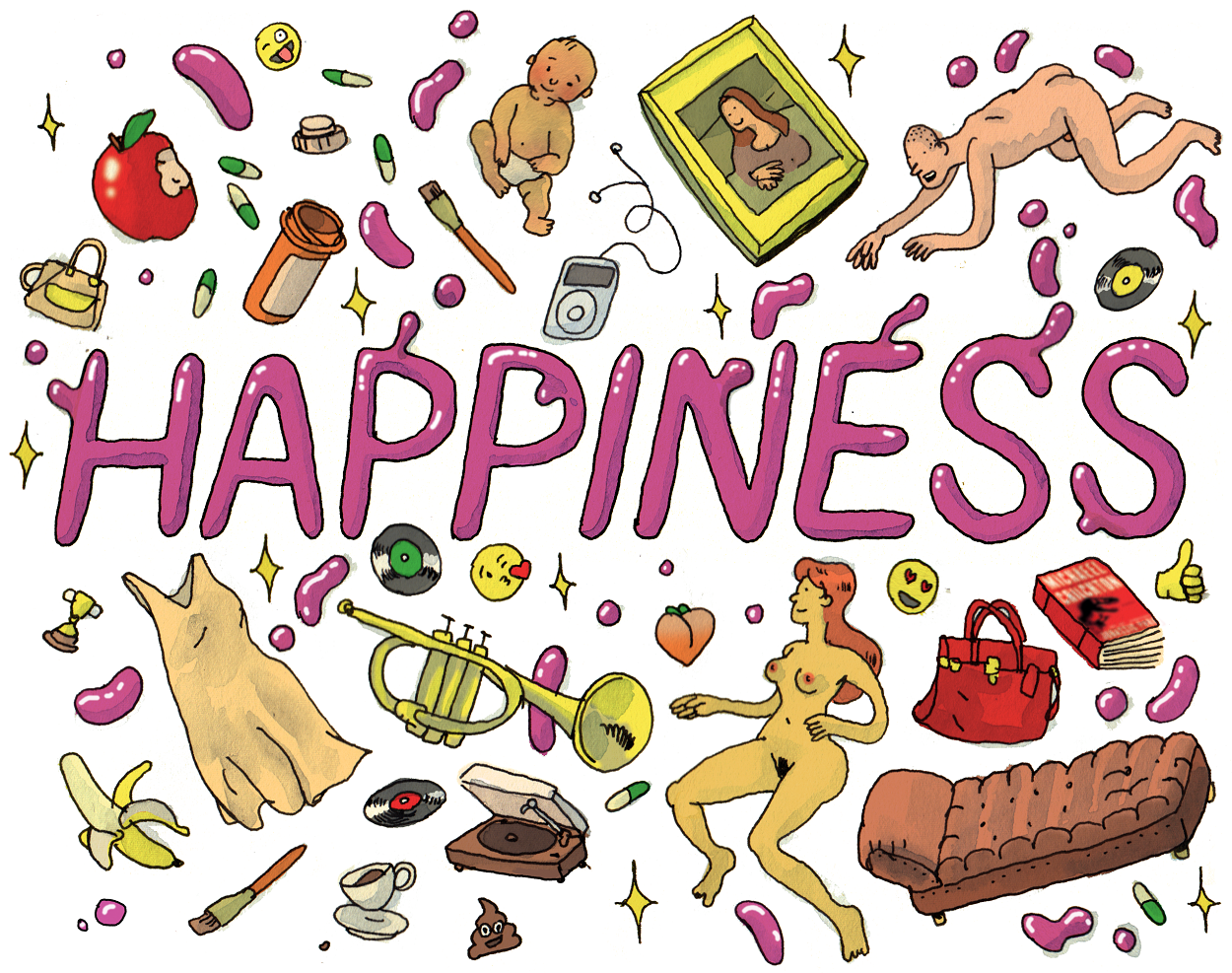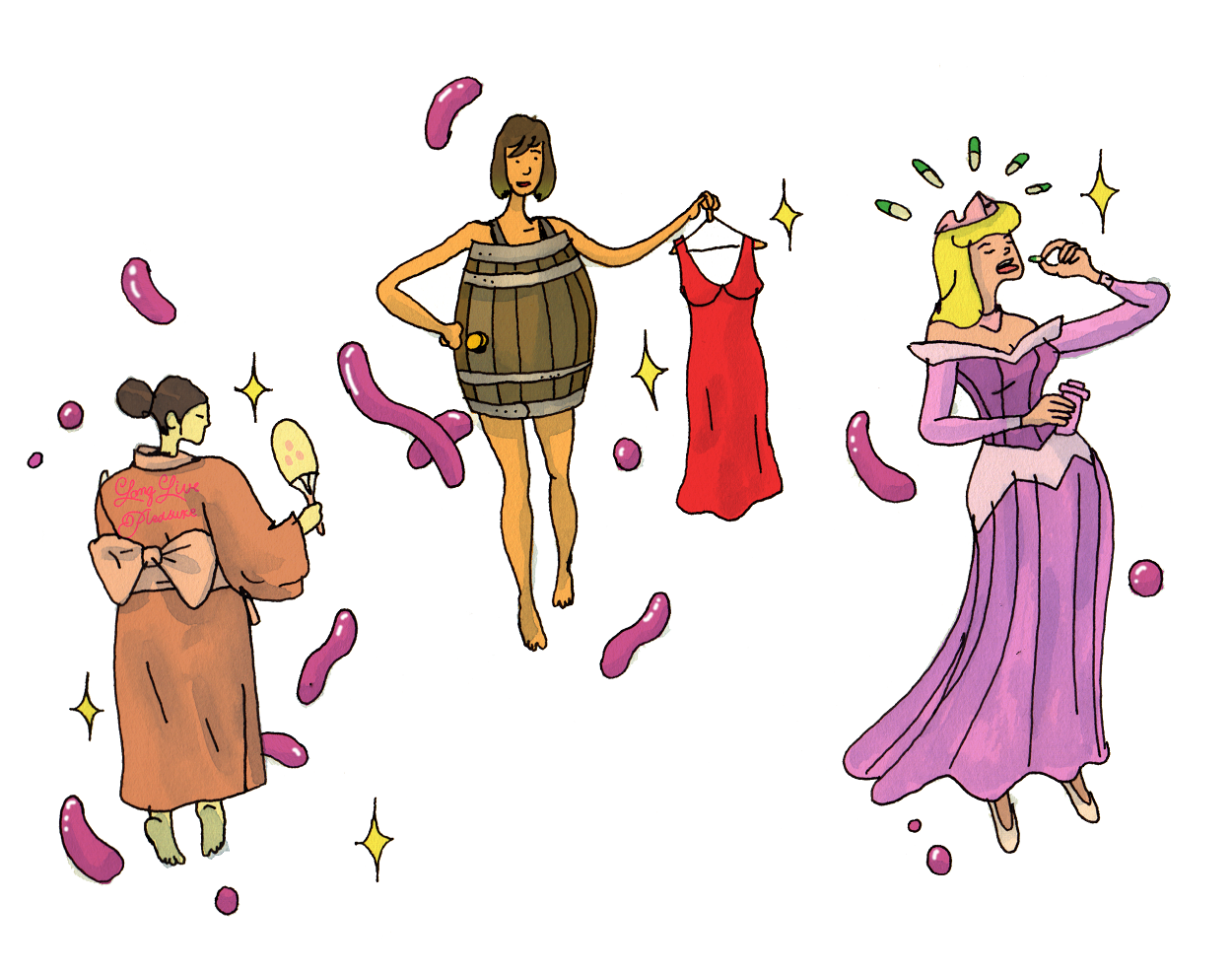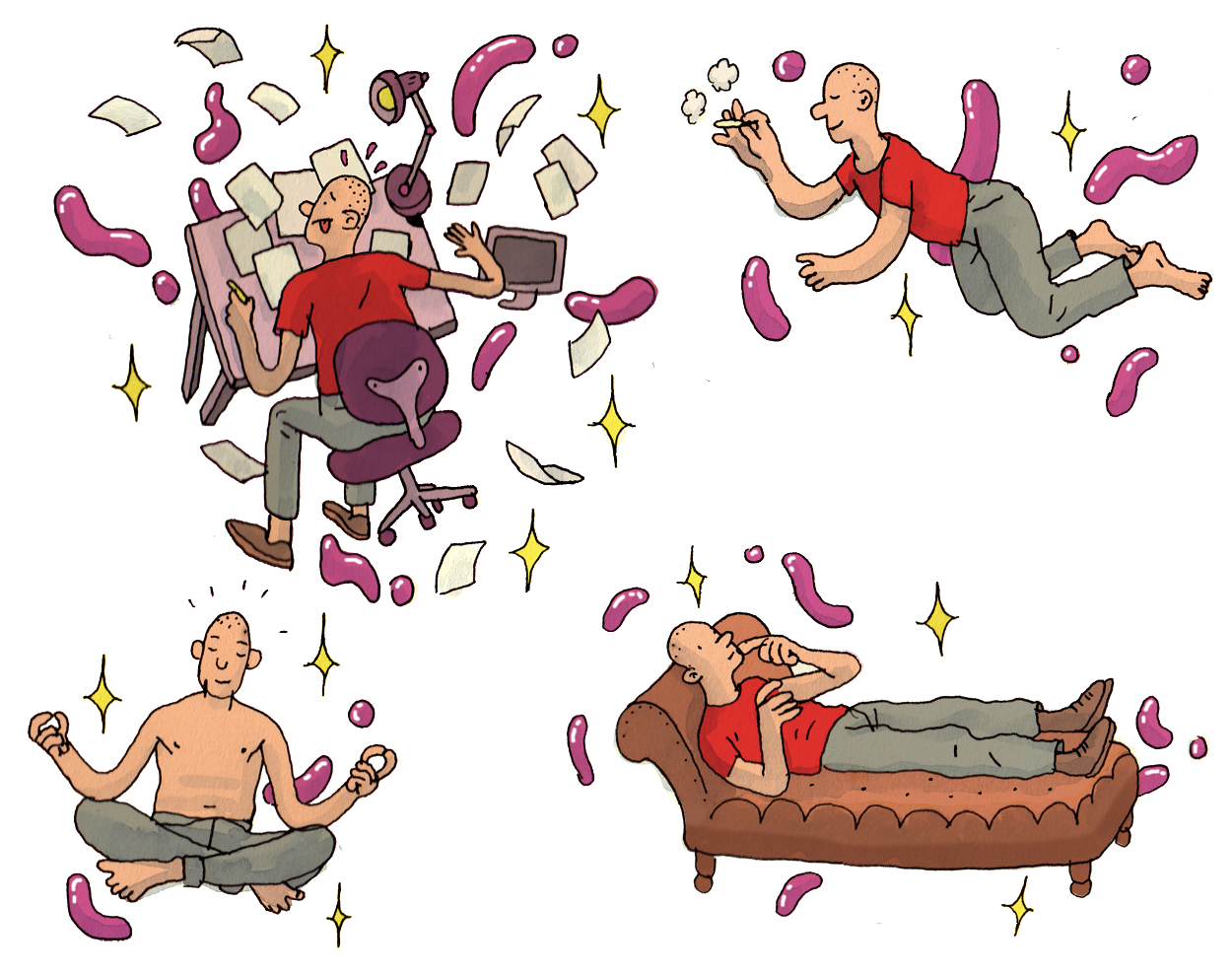FIT Museum director and curator Dr. Valerie Steele talks happiness with graphic designer Stefan Sagmeister, whose documentary, The Happy Film, debuted in 2016. This article was originally published in the March 2016 issue of Surface.
Valerie Steele: How do you view happiness?
Stefan Sagmeister: Three ways. One short one is bliss—an extraordinary moment, maybe an orgasm. Then there’s mid-length happiness, which is satisfaction or wellbeing, like if you’re on the couch with The New York Times on a Sunday afternoon and things are just right. Then there’s super-long-term happiness: finding that thing in life you’re good for or at, fulfilling your potential. All three of those things fall under the same term—happiness—but are totally different from each other. The orgasm has nothing to do with finding what you’re good for in life, and I think that’s why the term is so difficult to handle.
Steele: Of course. The first one is really about sensual pleasure. I remember once I saw a kimono that had belonged to a kabuki actor, and on the back it had characters that read “Long Live Pleasure”—with the subtext of sensual pleasure. I thought, “What a great thing for a tattoo!” It’s literally saying “Pleasure for Ten Thousand Years,” taking a short thing like bliss and stretching it out.
Sagmeister: I wonder how that went for that kabuki actor.
Steele: What a great—but impossible—slogan to live by. There’s also that old Aristotelian phrase “Living the good life is happiness.” Sort of in between, for me, is the happiness of flow, which is when you’re working on something and you’ve lost yourself it in. Which is so weird, because most people think of work as being labor. Yet when you’re working on a creative project and it’s going well, you don’t even notice that hours pass because you’re in the flow.
Sagmeister: I find that flow is the exact reason why so many people find computer games so compelling.
Steele: Probably so.
Sagmeister: Because of the different levels in a video game, you’re always working, by definition, at the edge of your abilities. You’re at the level in which you’re just at the edge. I last played computer games a very long time ago, but it was true for me, too—that you’d find yourself playing at 3 o’clock in the morning.
Steele: Yes, and if it was too easy, you’d find yourself bored and quit, and if it was too hard, you’d be annoyed and quit. It’s about finding that perfect spot in between, where you’re both challenged and excited.
Sagmeister: That definitely happens to me at work, but there’s so much other stuff to be taken care of that I can’t say it’s a daily occurrence.
Steele: Exactly. People always say to me, “You have the best job!” I’m like, “Really? Do you think I really spend all my time in the closet, looking at dresses, and setting up shows?” That would be the best job. But most of the time it’s HR, fundraising, and going to horrible Monday meetings. Where would you put something like shopping in this conversation of happiness? When asked “what are your hobbies?” a lot of people say, “I like to shop.” It’s a kind of pleasure-seeking, I guess.
Sagmeister: It’s definitely a seeking. Growing up [in Bregenz, Austria], my parents had a clothing store, which both of my brothers took over—one is doing men’s, one is doing women’s. They’re reporting that on the female side, but also increasingly on the male side, people shop because they want to increase their wellbeing.
Steele: Does that actually work?
Sagmeister: Research shows that if you’re making $85,000 or so a year in the U.S., making more makes no difference. Basically you’re topping out. If you have no money and then start making more, up to that amount the curb does go up a lot. Beyond that, most people trade: Yes, you cannot afford that Céline dress, but then there’s that shitty cousin always asking for money. As far as spending money is concerned, research shows that if you’re spending it on experiences it’s better than if you’re spending it on goods. The reason for that is that most people spend it on experiences that are non-repetitive. In contrast, the goods you buy create a peak, but then you get used to them and they don’t produce that feeling anymore.
Steele: This idea that your happiness [from making money] flat lines—it sort of depends, too, on your acquaintances. Because if you can buy the Céline dress, which would be taking up about 10 percent of your $85,000, what if all of your friends have $300,000, they’re buying lots of things, and your Céline dress is supposed to last you the whole season or year? I do notice people can get that momentary endorphin rush buying a piece of clothing, but by the time they’ve got it home, this feeling is fading, and by the time they’ve worn it once, it’s gone. Which is an incredibly discouraging thought.
Sagmeister: There are a number of studies out there that say if you’re going to spend money in the hopes that at the end of the day you’re going to feel better, the best strategy is to spend it on other people.
Steele: People say that all the time. No one acts on it, though. No one buys me Céline dresses. [Laughs] It’s true that a lot of people say they’d rather spend money on a great trip than another object. But studies show that trips can be frustrating and disappointing. In a way, the fun is often planning for the trip, and looking back on the trip, more than the trip itself. Which is another strange thing. I don’t find that true, although trips can be up and down.
Sagmeister: I got the chance to talk to Daniel Kahneman, who’s an economist but also worked in the world of social studies and happiness. He told me that he doesn’t take any studies seriously anymore that don’t differentiate between “in-the-moment happiness” and “on-reflection happiness.” The second one has much more to do with meaning. For example, in studies, if you ask women “what’s the best thing you’ve ever done in your life?” childbearing is always No. 1. When meaning comes into play, they’re completely satisfied they did that, but in the moment it was awful.
Steele: Exactly. Changing diapers wasn’t fun. Neither was the screaming baby. But looking back, you go, “Oh, that was so cute. That was so wonderful.”
Sagmeister: Kahneman realized that both in-the-moment happiness and on-reflection happiness are important. It’s not that one is not fake or not real. It’s just one is connected to “what was worthwhile to do?” while the other one is temporary.
Steele: In fashion, it’s not so much a happiness of consuming as it is of creating. Very little seems to have been done in terms of work on how creation works for not just the individual fashion designer—Chanel the genius, McQueen the genius—but the matrix of creativity around them that makes for that peak flow of experience, when something really great happens. Have you heard anything interesting done on that?
Sagmeister: The overall conclusion from “The Happy Show” exhibition and The Happy Film movie we’ve done, after having been involved in that world for 10 years now, would be that by and large I would have to find good relationships between myself and others—it can be a lot of others or just a few; a relationship between me and my work; and then a relationship between me and something that’s larger than myself—for many people that’s religion, but for me it’s not. When it comes to the work part, the best thing I’ve heard—and this is certainly the case for me—is that my work works when I feel it can utterly delight and help other people. An example is that I just saw the “Jean-Paul Gaultier: From the Sidewalk to the Catwalk” show in Munich. I have to admit that I was never a fan of his work, but I found some of the pieces in that show were so clearly delightful. Whether you were into that or not, you could feel how delighted people were just looking at that stuff. I’m sure that the people from the designer down to the embroiderers—people who spent tens of thousands of hours working on these—found these projects to be satisfying. If you create something that has lasting possibilities, it actually keeps paying the entire team. Some of the pieces in the show were 25 years old, but they still get accolades now.
Steele: It’s interesting when you think of someone like Gaultier, who seems to have been a fairly happy, well-adjusted person, as opposed to someone like McQueen, who was very much a tortured, dark individual. Yet if you look at this book by my friend Anne Deniau, Love Looks Not With the Eyes—she worked with McQueen for years—you have images not just of the shows, but of McQueen working with all these different people. You get that the collective project was really engrossing and deeply meaningful. It’s the idea of flow. You see more pictures of him smiling and happy when he’s in the process of creation. Clearly, what he got out of the experience with his team was really meaningful and life enhancing. McQueen said that working with Givenchy on the whole was negative, but his experience with the couture atelier there was fantastic. He said that what he learned from all of the craftspeople there was incomparable and raised what he did to a whole new level.
Sagmeister: I agree with that. It’s strange. I wouldn’t compare anything we do at my studio to what Mr. McQueen did, but we just finished The Happy Film after six years—we’ve done just a few friends-and-family screenings—and what I’ve heard back a lot was that even though the entire trajectory of the film was basically me seeing if I could make myself happier, people commented many times that the only time I actually looked decently satisfied in the film was when I was working.
Steele: Yes! [Laughs] I think that’s really true. A friend of mine from college just came back into my life, and we’ve been catching up on decades. She asked me, “What are you most proud of and satisfied with what you’re doing?” I said, “It’s that I’ve put together a really great team at the museum.” When we work together on an exhibition, it’s really a joy. When there’s a show we’re really captivated by—like “Gothic: Dark Glamour” [in 2008] or the Daphne Guinness show [in 2011]—everybody’s really pumped and working together at a very exciting level. It’s like being high. You’re all throwing ideas forward.
Sagmeister: Change helps a lot. Getting bored or even just adapting to how things are is an incredible drag on everybody’s well-being. So the possibility to go down different avenues or try new stuff out—or, in our case, to just get out from behind the screen and do something by hand or do a photo shoot or build something outside—is captivating. Just yesterday three of us from my studio were in the freezing cold, on the West Side Highway, for a two-hour shoot. That time not behind a screen put back a little spring in our step.
Steele: Change really is the best, even if you’re just moving from one kind of work to another. This makes me think that if buying things for yourself isn’t the happiness-inducing thing we tend to believe it to be, nevertheless that could presumably be modified if you improve the experience of it. For example, I know a lot of luxury stores talk about making it more “experiential”—welcoming, luxurious, something. Alternatively, there’s the idea that if you’re there with a friend and it becomes a relationship thing between you and friend, as opposed to just wandering through a department store being snubbed by clerks, it’s a more of a happy-making experience. Realistically, what do you think retailers can do to make the experience of shopping more interesting—apart from the fact that certain kinds of shopping are inherently more pleasurable? Shoe shopping is like the highest form of shopping: You’re never too old, you’re never too fat, the shoes are beautiful. Versus, say, bathingsuit shopping, which can be deeply humiliating and depressing.
Sagmeister: I use the term “experience in design” very carefully. We now have the “experience designer,” and everyone who’s designing a stupid website now thinks they’re designing an experience.
Steele: It’s become a total cliché.
Sagmeister: For me, I have an experience when I go to a rock concert—that’s a designed experience. Some people talk about unwrapping an iPhone as an experience because the packaging is so well done.
Steele: You mean so frustrating? [Laughs]
Sagmeister: I think it’s actually not so frustrating. But I use this “experience in design” term very carefully in that commercial world. It’s the same with people who talk about the importance of storytelling.
Steele: Right. These ideas become so banal.
Sagmeister: These people all say they’re thinking outside of the box, but of course none of them are. I think research would back it up that an experience—specifically a non-repetitive experience—would be more efficient in yielding a higher-wellbeing possibility than the material goods we buy. I think the designing of the experience has some inherent difficulties, one of them being that it’s a commercial experience. Most of us become very suspicious immediately from the commercial world, because they clearly want something from us.
Steele: Even children can suss that out.


